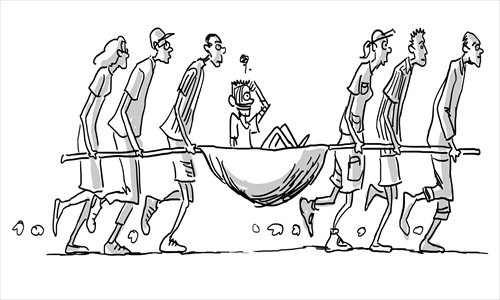Volunteers' work brought hope to stricken regions

The rescue work after the April 20 earthquake that hit Ya'an, Sichuan Province is coming to a close. The stricken area, which has drawn nationwide concern, is getting on track to rebuild from the rubble.
As a TV reporter who entered the frontlines of the earthquake, I have noticed some fresh arguments about the role of volunteers in the quake-stricken area. Whether these arguments have been set out by on-site rescuers or at-home commentators, I feel responsible for restoring a true image of these volunteers based on my own observations.
The nation's response to the earthquake was lightning fast. When I flew to the afflicted area hours after the quake, huge bulks of relief supplies had already been shipped to Lushan county, the epicenter of the quake.
Trucks and cars were lining along the highway, and a continuous flow of replenishment guaranteed that as long as the stricken areas were accessible, the abundant relief supplies were able to reach the victims.
In the meantime, a large number of volunteers, who were mostly from the surrounding areas in Sichuan Province, headed to the disaster zone.
I came across a couple of male volunteers soon after I came to Lushan county. It was night, and they made a fire along the road to keep warm. They told me that as university students who experienced the Wenchuan earthquake in 2008, they had trained well in the rescue techniques in recent years and felt responsible for helping others this time.
They had a car, but they left it for some female volunteers to sleep in, and they would rather suffer the cold outside than use any relief supplies such as a tent, although the supplies were quite sufficient in Lushan county.
What shocked and touched me most was the scene along the winding and dangerous road to further mountainous areas. Since the roads into these areas were just reopened, conditions were bad and there was the danger of avalanches.
So trucks and other large vehicles could not get to regions which were in dire need of help. But many volunteers chose to risk their lives and walked into the most afflicted areas, piggybacking as many supplies as possible to relieve the mountainous victims.
Although volunteers have come in for criticism as being less organized and possibly blocking the traffic, it is undeniable that they made a tremendous contribution to areas that needed help most during the initial post-earthquake period.
Because for every victim who suffered cold and hunger and temporarily and couldn't be relieved by the government due to the inaccessible roads, volunteers brought relief supplies to sustain them.
Generally speaking, the individual relief offered by volunteers could not have as much effect as the highly organized and financially strong government relief, but volunteers focused on every individual who was in dire need of help at that critical moment.
It is undoubtedly true that the non-rescuers including volunteers and journalists consumed a few resources in the disaster areas and increased the traffic pressure, but the significance of their contributions to the relief work was far greater than the negative impact of the "trouble" they made.
As a reporter and, to some extent, a volunteer who once distributed my own supplies to the victims in the most afflicted areas, I believe that the personal qualities of volunteers and the professionalism of journalists are the critical factors that can maximize and improve their positive influence in the disaster areas.
If volunteers can help within their capabilities, and journalists can speak truthfully, this will make the rescue work more organized and efficient.
The article was compiled by Global Times reporter Liu Zhun, based on an interview with Kevin Chan, a TV reporter based in Beijing. liuzhun@globaltimes.com.cn
Rescuers go astray in well-meaning quake efforts